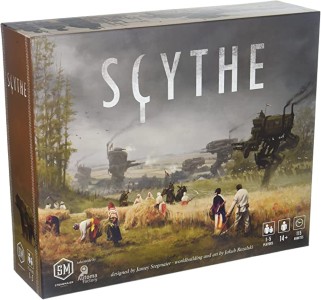



play board games
Board game reviews, strategy tips & session reports
Scythe Board Game Review
 Stats:
Stats:
No. of players: 1-5
Amount of time to play: 90-115 min
Age requirements: 14+
Set-up time: 5-10 min
Scythe is an engine-building, strategy board game that combines engine-building, area control, resource management, and combat mechanics.
Scythe Rules Description:
You start Scythe with a random player board and faction. Both of which are unique. The game ends once one player has obtained six objectives.
On your turn you take one action that is split into two parts. The top is free or costs one coin, but the second action costs resources gathered from the board. If you have the resources to pay for the second action you may take it too. Each player board is unique. The top actions are aligned to different bottom actions and the bottom actions cost a different number of resources.
Top actions include move, trade, bolster, and produce. The move action, as you would expect, lets you move units around the board. Trade costs one gold to gain any two resources or increase your popularity by one. When you bolster it also costs one gold to gain two power or a combat card. And the produce action adds resources to two spaces where you have workers. It is free to start but the cost increases the more workers you have in play. The type of resource is determined by its terrain and the amount is based on the number of workers there.
The bottom row actions’ costs vary but consist of the upgrade, deploy, enlist and build actions. The upgrade action allows you to take a cube from a top row action and cover a cost in the bottom row. This will improve the things you gain with the top row action and make the bottom row action cheaper. This action costs oil.
You get mechs onto the board with the deploy action. They cost iron and must start in a space where you have a worker. When you move a mech it may take workers and resources with it.
When you use the enlist action you instantly gain a one-time bonus. You also gain an ongoing bonus anytime you or your neighbors take that action for the rest of the game.
Build costs wood and allows you to place one of the four buildings onto the board. The mill helps you gain more resources, the mine allows you to move to any space marked with a tunnel, the monument gets you one popularity, and the armory improves the trade action to also give you one power when used.
If your mechs or character end in a space with another player’s mechs or characters, combat ensues. Combat is resolved by secretly choosing the amount of power (up to seven) that you wish to spend and adding any combat cards you wish to spend. You may play as many combat cards as you have units. Then you compare the total power for each side. The loser’s units must retreat to their base. The winner controls that spot and keeps any resources there. They have also completed an objective.
Once a player claims six objectives the game ends. Players gain points for their coins, number of spaces they control, and the objectives they have reached. Each of these scoring categories is also multiplied by up to three based on your final popularity. The player with the most coins wins.
Quick Review of Scythe:
Scythe combines many different game mechanics to create a fun board game. It may not be for new gamers but more experienced players will enjoy it.
The components for this game are excellent. From the artwork to the miniatures everything looks great and is well made. The rules are well written and you can even go through this online tutorial if you are having trouble understanding things.
Like I said above, Scythe combines some common board game mechanics, including: worker placement, area control, resource management, engine-building, and combat. This board game does a great job blending them into a fun, yet complex, system that uses four different resources (wood, food, oil, and steel) and three different currencies (coins, power, and popularity).
You might think this game would become stale after several plays, but the different factions and variable player boards keeps things fresh and adds variety. In fact after you get a handle on the basic gameplay, you can start to hone your skill on using the different faction/player board combinations.
New players should be warned they will probably not win their first game. But it will help them understand the mechanics (which is not hard) and grasp the strategy (which might take a game or two). I think most new players understand this concept when playing more complex games, but it can be helpful so they don’t get discouraged. You should also give them pointers and remind them of how important popularity is for scoring.
Scythe is a fun board game that is fun and full of interesting decisions. It is definitely one board game I suggest everyone try. There is even a digital version that might help introduce you. If you have read this and other reviews and you think your group will enjoy it, just buy it. You won’t regret it.
Score and synopsis: (Click here for an explanation of these review categories.)
Strategy 5 out of 6
Luck 2 out of 6
Player Interaction 5 of 6
Replay Value 5 out of 6
Complexity 5 out of 6
Fun 5 out of 6
Overall 5 out of 6

Leave a Reply